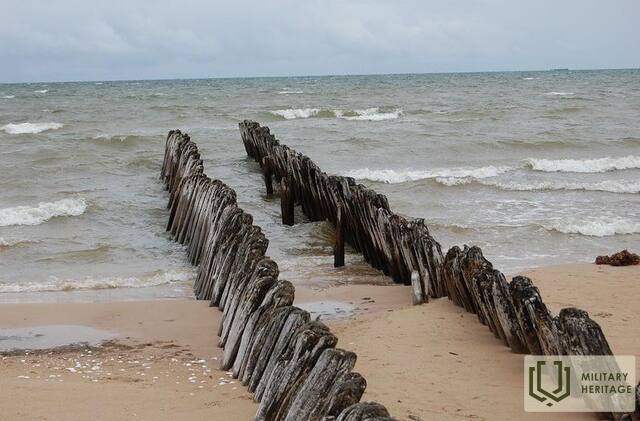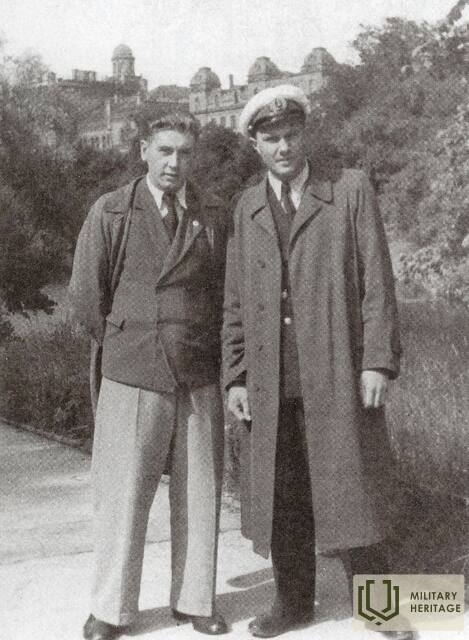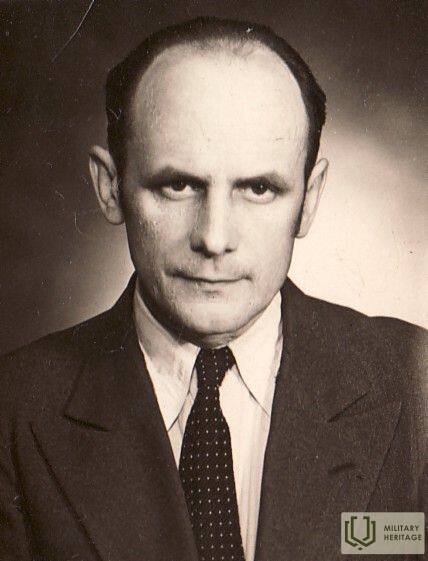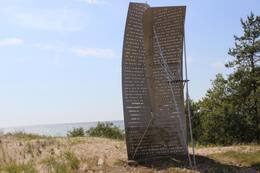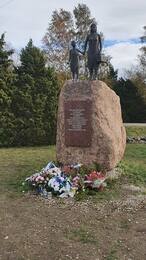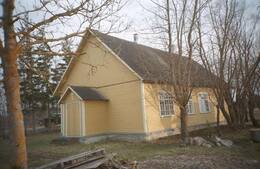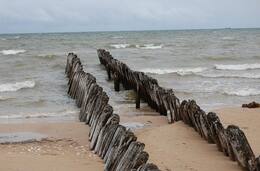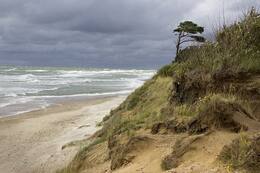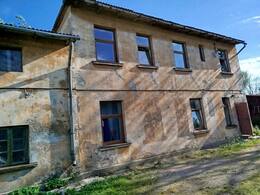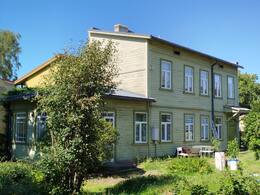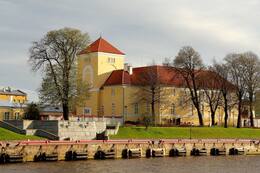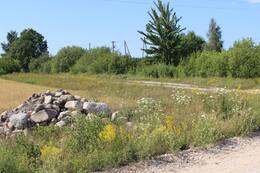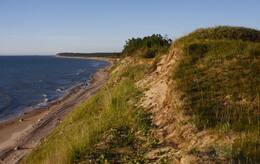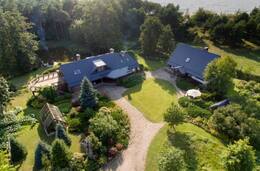WW2 refugees II World War II
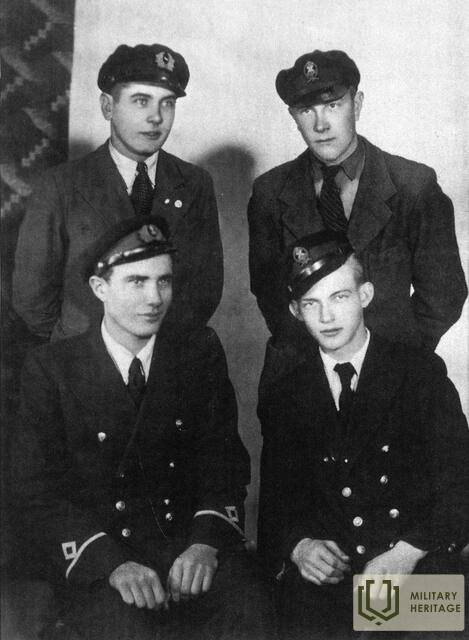
The repressions, arrests and deportations during the first Soviet occupation of Latvia from 1940 to 1941 deeply shocked many Latvians. As a result, when the Soviet army again approached Latvia in 1944 and threatened a second occupation, more than 200,000 (~10%) of the Latvian population left their homes in the flames of war and, risking their lives, sought refuge in the West, in territory controlled by the German regime, because there was no certainty that the communists would not deport them to Siberia.
About 160,000 of them were civilians, mostly refugees; 30,000 were soldiers who had been drafted into the Latvian Legion, while 10,000 were sent to work in Germany. During the war, many lost their lives while fleeing, many of them were caught by the Soviet army, so at the end of the war, about 114,000 Latvians remained in the former German territory.
Not all refugees made it to Germany. In secret voyages in small fishing boats, about 3,000 Latvian refugees were transferred across the sea to Sweden, later joined by other Latvians from Denmark and Germany. Leaving their homes, almost all refugees thought that their absence would be temporary, that the Allied armies would continue the war until all the communist-held lands were liberated. These hopes were not fulfilled, and in time the refugees had to look for permanent homes outside Europe.
More information sources
http://pedas.lapamuzejs.lv/?page_id=1180 (accessed 4.11.2021)
https://lv.wikipedia.org/wiki/Pirm%C4%81_pasaules_kara_latvie%C5%A1u_b%C4%93g%C4%BCi
57.0646
Related timeline
Related objects
Memorial sign for refugees "Sail of Hope" in Jūrkalne
The "Sail of Hope" commemorative sign for the World War II refugees who crossed the Baltic Sea by boat to the island of Gotland in Sweden in 1944 and 1945. The memorial is located in Osvalki on the dunes between the sea and Ventspils-Liepaja highway, near the public transport stop "Kaijas". It was created by sculptor Ģirts Burvis, who realised it as a sail of hope symbolising the memory of Latvian refugees.
Between autumn 1944 and spring 1945, fearing the renewed Soviet occupation but unwilling to evacuate to a devastated and threatened Germany, some Latvian citizens tried to reach the nearest neutral country, Sweden, by sea. Some of the boats were organised by the Latvian Central Council with the help of the Western Allied countries, which resulted in one of the largest refugee concentration points in Jūrkalnes parish. Besides the boats organised by the Latvian Central Council, other boats were also taken across the sea. It is estimated that about 5000 persons managed to cross the sea. The number of deaths is unknown, as no records were kept of refugees leaving the Kurzeme coast.
The voyages were dangerous because the refugees were threatened by German patrols on the coast and at sea, sea mines, Soviet aircraft and warships, as well as storms, as the crossings often took place in unsuitable and overloaded cutters and boats without sufficient fuel and food supplies, sea charts and navigational instruments. Departures from Latvia were carried out in secret. The destination of the boats was the island of Gotland, and the journeys most often started on the west coast of Courland (from Jūrkalne to Gotland is 90 nautical miles or about 170 kilometres as the crow flies).
Monument to those who fled across the sea to Sweden in 1944
This monument is situated on the water’s edge on Cape Puise. In 1944, around 80,000 people fled westward from the advancing Red Army, many of them by sea. This monument, commemorating that mass flight, was designed by Aivar Simson. The idea originated from Heidi Ivask, who, held in her mother's arms, was one of many who waited for a boat on the beach in Puise. Construction of the monument was led by the Estonian Memento Union.
Põgari House of Prayer
This house of prayer in situated in the village of Põgari-Sassi near the 1 km marker on the Tuuru-Puise road. On 18 September 1944, the day after the Germans began their retreat, Prime Minister Jüri Uluots, serving as the head of state, swore in the new Government of the Republic of Estonia. The Government adopted a resolution on the restoration of the independence of Estonia and on remaining neutral in the war. The inauguration of the government meant that the Red Army did not ‘liberate’ Estonia from the German occupying forces, but rather occupied an independent nation. The cabinet of Otto Tief held their last meeting at the Põgari Baptist house of prayer on 22 September 1944. This historic meeting is commemorated by a memorial tablet there, unveiled by Prime Minister Mart Laar in 1999. Tief's cabinet members were waiting at the house of prayer for the promised motorboat to be evacuated to Sweden. However, the boat was delayed, arriving on 29 September, and only State Secretary Helmut Maandi fled, carrying a copy of Riigi Teataja confirming the continuity of the Republic of Estonia.
The Mazirbe coast, from where refugee boat traffic to Sweden took place in 1944
The Mazirbe coast was an important place during World War II, from where refugee boat traffic to Sweden took place in 1944.
Memories of boat refugee Ilona Cīrule (nee Mālītis): “I was 13 years old at the time. I remember that at the end of September we traveled in a caravan from Riga to Mazirbe for a whole week. The trip remains in my memory as something unpleasant: the Russian candles in the sky worried me to the core. We lived in Mazirbe for about three weeks, and every day I heard talk about crossing over and about looking for boats. Finally, on October 21, we had to get ready. [..] There were about 90 of us on the boat. I sat on my father’s lap on the deck. The small children with their mothers were below, and they were short of air. I must have been dozing, but in the morning of the next day a plane was spotted and a ship on the horizon. Then the people became quiet. In the afternoon, the ship came again, and this time it came right at us. But it happened like in a fairy tale: it was a Swedish military ship! They pulled us all onto the ship, gave us warm cocoa and took us to the port of Nynashamn. Our boat was tied to the ship and its owner Zariņš-Petravs received it safe and sound. Among the guests were Šici, Zanderi, Vanagi, the former Minister of Justice Mrs. Apsīša, our family and others. I know that the boat had to be paid in gold. But how much - I don't know.
The steep bank of Staldzene, from which refugee boat traffic to Sweden took place in 1944
In 1944, there was active refugee boat traffic from the Staldzene cliffs to the shores of Sweden.
Ž. Lapuķis' memories of meeting with Dr. E. Bakusis:
“One afternoon, a local police officer came to me and quietly told me that a boat from Sweden was expected to arrive that night near the village of Staldzene near the Koku hills to pick up refugees. My task was to come with a group of guards from my unit to guard this place and, if necessary, help to transport the refugees to the motorboat. [..] Not far from the sea, without waiting, a man stood in front of us on the rope, wearing a gray half-coat with a turned-up collar and a jockey's hat pulled low on his forehead. He said a quiet good evening and asked: “Is this the road to Lošupi?” That was the watchword for Swedish riders in that place. He said that he was here on a special mission, but at the same time he would like to get his family to Sweden safely. Then, to my great surprise, he pulled out our forestry plan from his pocket. In the twilight, I began to watch the stranger's face and soon recognized him. It was Bakūzis, the head of the Forestry Department's Forestry Management Division [..] It was approaching midnight when we saw a black dot in the distance in the sea. We gave the agreed signal with a flashlight, repeating it several times. After a short while, the same answer came from the black dot, only it was not from a flashlight, but the light transmission of a warship. We realized that the boat was no longer expected that night and the group of refugees was starting to disperse. Bakūzis invited us both with the company commander to stay with his family. We found it in a hollow in the dunes under a thick fir tree. There, in the green moss, with their heads resting on a white pillow, three offspring of this family were lying in a deep sleep, and next to them, with a white scarf around their heads, sat the caring mother of the house. The father of the house found a bottle and the mother of the house offered sandwiches. It seemed that with their Latvian sincerity they were the real father and mother of the house, who had found their home on this rainy autumn night under the fir tree of their homeland. On one side the sea hisses, on the other a forest massif and heavy raindrops slowly fall through the branches of the fir tree. We emptied the bottle, but refused the sandwiches, because we realized that they needed them more themselves.
The building in Ventspils where LCP liaison Valentine Jaunzeme (Lasmane) lived in 1944
The house at Lauku Street 4, Ventspils, was home to the teacher Valentīne Lasmane (nee Jaunzeme) (1916–2018). She was a liaison officer for the Latvian Communist Party and a member of the Ventspils liaison group. After World War II, she lived in Sweden.
She compiled the testimonies of 130 boat refugees in the publication “Across the Sea 1944/1945” (Stockholm, 1990), but V. Lasmane's own life story can be read in the book “Night is No Longer Just for Sleeping” (Riga, 2020). In 2000, she was awarded the Order of the Three Stars. She died at the age of 102 in 2018 in the Stockholm suburb of Täby.
The building in Ventspils where Dr. Valdemārs Ģinters, a representative of the Latvian Communist Party and organizer of refugee boat traffic in Kurzeme, lived in 1944-1945.
The house at Katrīnes Street 4, Ventspils, where archaeologist Valdemārs Ģinters worked.
From October 1944 to May 8, 1945, the LCP representative in Kurzeme was archaeologist Valdemārs Ģinters (nicknames “Doctor”, “Gardener”) (1899–1979). Participant in the Latvian War of Independence, director of the State Historical Museum and docent at the University of Latvia. Awarded the Lāčplēsis War Order and the Three Star Order. One of the signatories of the LCP memorandum of March 17, 1944. After World War II, he lived in Sweden. From 1949 to 1979, he was chairman of the board of the Latvian National Foundation.
Prison in the Livonian Order Castle during World War II
Several members of the LCP Ventspils communications group and refugee boat operators were detained in the prison established in the Livonian Order Castle in 1944-1945.
Memories of the boatman Žanis Fonzovs: “Two boats left Sweden - “Krīvs” and “Zvejnieks”. I was on “Zvejnieks”, and the crew included Saulīte and Grunti. [..] The weather was beautiful, I was sailing so inconspicuously, not very high. I immediately saw - I was in Morse code. The boat was approaching. I went down to the engine room, because in addition to Saulīte's papers, I also had letters from the arrivals to relatives in Latvia and the collected weapons in a bag. I threw the letters and papers into that bag of weapons and everything overboard.. What then! The boat approached ours and the Germans asked for our driving permits. [..] So on October 21, the Germans took us with the entire “Zvejnieks” to Ventspils. They took us to prison. There were about 30 people in the room. I had a sheepskin coat on my back, I put it on the floor and put it on myself, but I had not slept last night. On the second or third day, they called us out for questioning. We had agreed to say that we were refugees on our way to Germany. I had just wanted to go to Lielirbe to follow my friend. It seems that they believed us then. [..] But then the situation in Ventspils changed: the city was taken over by the military administration, and we were called in for questioning a second time. It was worse, because they showed us a box of Swedish matches and a piece of kroon that were allegedly found on the boat. One of the interrogators was a Latvian, and he even beheaded us for telling the whole truth. We saw that the fairy tale had ended, we simply had to confess.
The road to the "Grīnieki" house in Vārve parish
The road to the “Grīnieki” houses in Vārve parish, where in 1944 one of the main settlements for boat refugees on the Kurzeme coast was located.
Memories of boatman V. Jurjakas: “Entering the “Grīnieki” yard, everything looks very normal. A quiet country house, not a soul, probably people in the sun. [..] It turned out that not only the “Grīnieki” residential house was full of people, but all the buildings were full. The barn, the granary, the hayloft and the bathhouse. I met one or two acquaintances, because it was time to leave our land. [..] The nutritional situation was not critical, but quite poor. [..] In the evening, the refugee caravan began to move towards the seashore. I warned everyone in advance not to come out of the bushes by the seashore, because there were coast guard dugouts and observation posts nearby. It was a large caravan, because about 200 people were going to the seashore. There was no hope that everyone would arrive on time. The evening was not very dark, and I was able to review the activities of the entire group. The most striking were the large "When people lived in "Grīnieki", they didn't see them, but now, when they were brought into the light, they only saw this. The goods alone required a whole boat. 3-4 two-horse carts were loaded with goods, followed by people. [..] We waited for the boat for a long time, but it didn't come. The whole caravan had to turn back. It was very dark."
Temporary refugee shelters "Vārves būda"
"Vārves būdas", a place in Ventspils municipality that served as temporary housing for Latvian refugees who were waiting for boats from Gotland to arrive in 1944.
Memories of the boatman V. Jurjaks:
“My half-brother and his family had come to us from Riga, and when the news came that a boat was expected at Vārve, I united these people of mine with the group of police chief Jasūnas and we all set out for Vārve. We waited for the signals until late at night, but the boat did not arrive. We waited there like that for a whole week. It started to rain. People made tents out of sheets, so we called this place “Vārve huts”. My wife and I spent more time in Ventspils during the day, and eventually we had to think about how to deliver food to those waiting. I remember one night my wife and I were carrying hot boiled potatoes through the forest for them on our bicycles. It was raining heavily, lightning was roaring, and the warm potatoes tasted good to the waiting people who had spilled out. The Vārve forester had accidentally discovered this hiding place, but - promising him the possibility of a transfer, he came to help. The Germans had begun to go through the houses of the coastal residents, looking for people in the years of conscription. Two young people had been caught in the forest near the “Vārve huts”. Therefore, this place could no longer be safe for these more than fifty people who were languishing here.
"Bambaļi" houses - one of the main accommodation places for boat refugees
The restored “Bambaļi” houses in Ošvalki, Jūrkalne parish, which in 1944 was one of the main places of accommodation for boat refugees on the Kurzeme coast.
Memories of boat refugee Kārlis Draviņš: ““Bambaļi” were old, small, very run-down houses in Jūrkalne parish, about 40 kilometers from Ventspils. [..] Small fields spread around in a damp place, but on the other side an old, overgrown dune wrapped itself around it. The sea gurgled a little behind it - the houses were right next to the sea. On the other side, half a kilometer away, the Pāvilosta-Užava highway ran, but the road to the houses was not easy to drive on, which is why the Germans could not be everyday guests here. The place where boats were waiting was easily accessible - a small forest clearing on a high bank. [..]
The owner of "Bambaļi" and her group, who were also waiting for the "movement of the water", lived in two rooms facing the sea, but the group of refugees lived at the other end of the house, also in two rooms. They shared the kitchen. The hallway between the two ends was stuffed with the refugees' many belongings. The rooms were filled with straw, which was spread out along the walls. On each side of the room was one bed, where a mother and her children slept. The straw beds were covered with sheets or something else during the day. They came out to sit or sleep in them during the day, because there was nowhere else to stay. [..] The days passed monotonously, one after the other. They got up on command, there was no hurry. When the communal breakfast was eaten, some went to play cards, some took up fortune-telling, while others tried to read. Some had to do household chores - fetch firewood, water.
"Laukgaļi" houses, the residence of the writer Kārlis Skalbe
“Laukgaļi” in Jūrkalne parish, the place where writer Kārlis Skalbe stayed in October - November 1944, while waiting for a refugee boat to Sweden.
Writer Kārlis Skalbe (1879–1945) was a member of the Latvian Provisional National Council and the Latvian People's Council, a deputy of the Constitutional Assembly of the Republic of Latvia and the 1st and 4th Saeima. During the German occupation, he was the editor-in-chief of the literary magazine "Latvju Mēnešraksts", one of the signatories of the LCP memorandum of March 17, 1944.
On November 11, 1944, she fled to Sweden. She died in 1945 in Stockholm.
Pāvilosta local history museum exposition
Named ‘Pāvilosta, a Closed Area’, the exhibit in the Pāvilosta Local History Museum is about everyday life in the town of Pāvilosta during the Soviet occupation; specifically, about the executive branch, border area, fishermen’s collective farm, and the cultural and social activities. In addition to the permanent exhibit, there is an interactive and emotionally rich digital exhibit in two languages and an audio-visual installation offering a film about Pāvilosta.
The museum also features a new exhibit named ‘The Golden Sand Grains of Pāvilosta’. The digital installation showcases old events, how Pāvilosta was founded and the most important developments from 1918 to the present day. Military heritage is a point of focus in the War of Independence section, which tells a story about the freedom fighters of Latvia and the time of the Soviet occupation.
Lestene Brothers' Cemetery
Located in Tukums region, Lestene, next to the church.
The creation of the mass grave in Lestene began in 1998. It is the second largest military cemetery in Latvia, where more than 1,300 Latvian legionnaires are buried. Only after the restoration of the Republic of Latvia was it possible to rebury Latvian soldiers who fell in World War II from various places.
The Latvian Legion was a combat unit of the German army, formed mainly from illegally mobilized Latvian residents. The soldiers perceived their presence in the legion as a fight for the restoration of Latvian independence, despite the fact that it took place within the ranks of the German armed forces and Germany had occupied Latvia. There was no other military force that could delay the return of the Soviet occupation. The Latvian legionnaires fought against the Red Army, which had liquidated the independence of Latvia, destroyed its army and committed crimes against the civilian population. About 110,000–115,000 soldiers fought in the ranks of the German army, about 30,000–50,000 of them lost their lives on the battlefields.
Nowadays, in Lestene you can visit the Brothers' Grave, next to which is the Lestene Church. It is an outstanding example of Baroque sacred art. In the ancient church tavern you can get acquainted with an exhibition dedicated to the history of the Latvian Legion. The central image of the brothers' grave, "Homeland - Mother - Latvia", was created by sculptor Arta Dumpe. Nearby is the Lestene Manor, which belonged to Latvian Army General Mārtiņš Hartmanis before World War II.
Tours of the Lestene Church can be booked with the parish priest of the Lestene Evangelical Lutheran Church, Inguna Kokina, phone +371 29993743.
Related stories
Valentina Lasmane's successful escape
A biographical story written by Valentīne Lasmane about how she managed to escape from detention during the German occupation
The last birthday celebration of Kārlis Skalbe on the Kurzeme coast
On November 7, 1944, a bright mood was brought to the Latvian refugee settlement on the Kurzeme coast by the commemorations of the poet Kārlis Skalbe’s 65th birthday in the “Laukgaļi” in Jūrkalne. Just four days later, Kārlis Skalbe set off by boat to Sweden as a refugee. It was the day when Kārlis Skalbe celebrated his birthday for the last time.
The secret and dangerous activities of Valdemārs Ģinters
Valdemārs Ģinters' name was the last hope for many Latvian refugees to escape to Sweden. Too much attention from the refugees was dangerous, and therefore Ģinters kept it a secret.
Refugee boat transfer point from the Kurzeme coast to Sweden near the "Pāži" houses
One of the important places of relocation was near the “Pāži” house, where a monument has now been erected - “Sail of Hope”. “The ships came regularly and the most people left from “Pāži”, says the memories of I. Freibergs.




